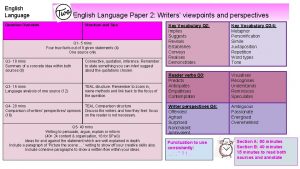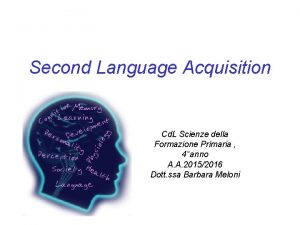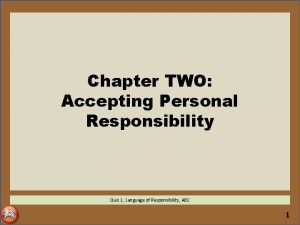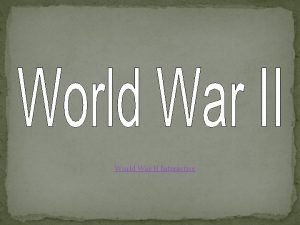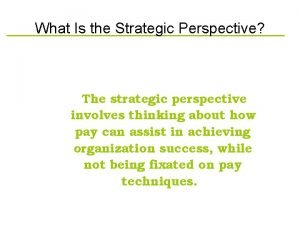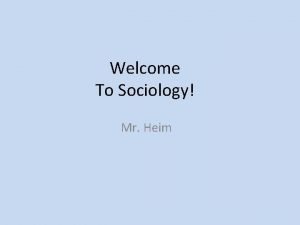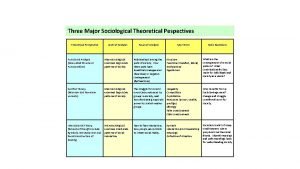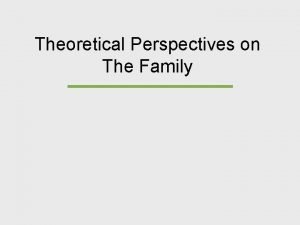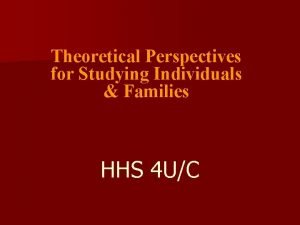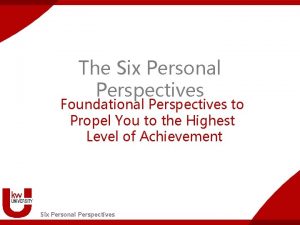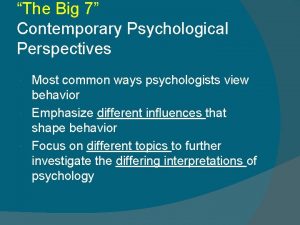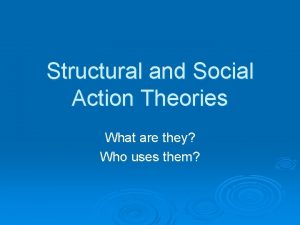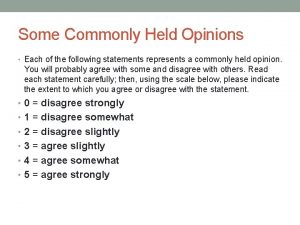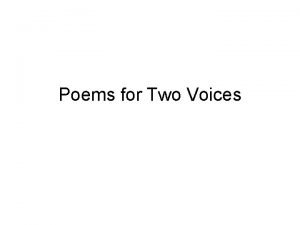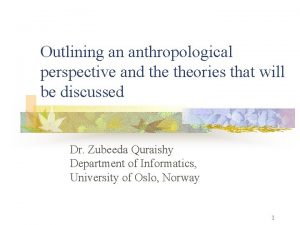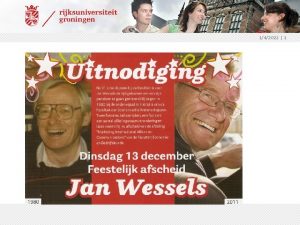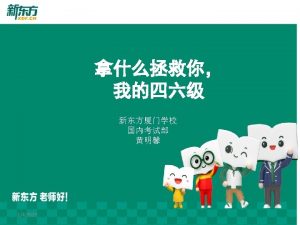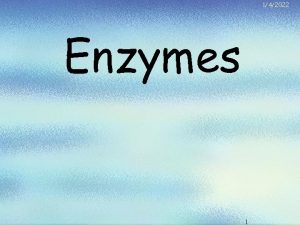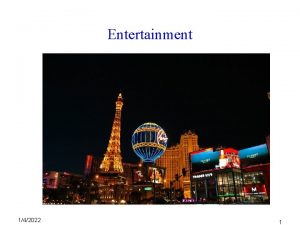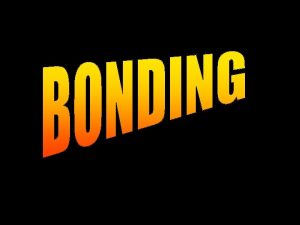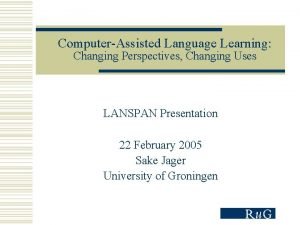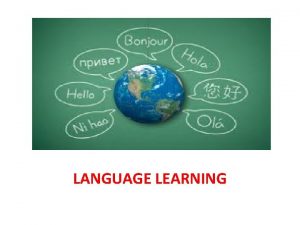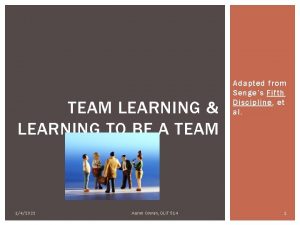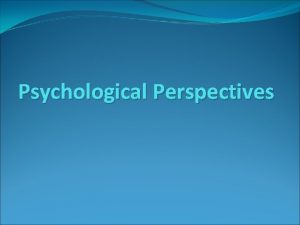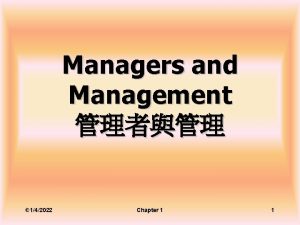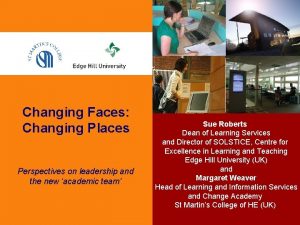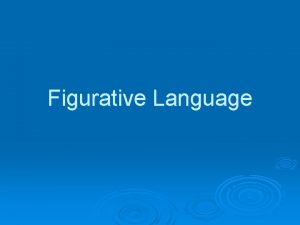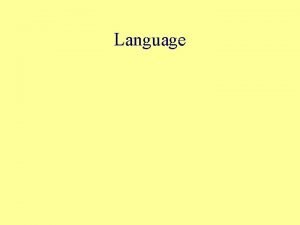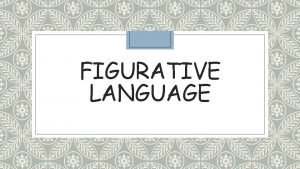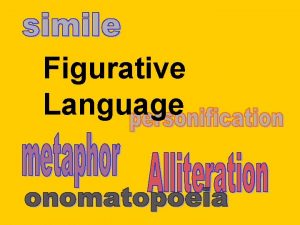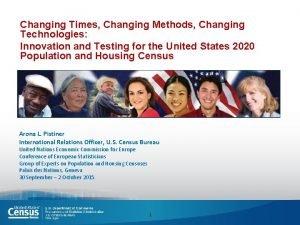142022 1 ICTIntegrated Language Learning Changing perspectives changing


















- Slides: 18

1/4/2022 | 1 ICT-Integrated Language Learning Changing perspectives, changing uses › Eurocall 2007, University of Ulster › Sake Jager

1/4/20222 Outline › › ICT-integrated language learning Language innovation project University of Groningen Presentation of some materials developed Discussion and questions

1/4/20223 Integration › Oxford Advanced Learner’s Dictionary: › Technology and language learning ‘things’ to be combined in CALL › Integration should also take into account other aspects, such as educational environment › General framework provided by Collis and Moonen (2001)

1/4/20224 Key components technology-enhanced learning Institution Implementation Pedagogy Technology Based on Collis & Moonen (2001)

1/4/20225 Key components in relation to other studies › Implicit or explicit reference to components › Laurillard (2003): • Pedagogy: Conversational Framework • Technology: Media properties in support of CF • Institution: Effective organisational infrastructure › Barr (2004): • Pedagogy: Facilitation of learning approaches • Technology: Technical sufficiency, integrated infrastructure • Institution: Growing a culture, time, human resources, strategic planning

1/4/20226 Key components in relation to other studies › Taalas (2005): • Pedagogy: Add-in uses rather than add-on uses • Technology: Multimodal learning environments • Institution: Staff development, transformation of teaching practices

1/4/20227 Integration vs normalisation › Normalisation, Bax (2003): • “stage when the technology becomes invisible, embedded in everyday practice and hence ‘normalised’” (23) • End goal of CALL › See Levy and Stockwell (2006) for discussion › Integration is a continuous process rather than an end goal: • As new technologies emerge, new forms of integrating technology, pedagogy, institutional aspects are required • Field of CALL as a whole will never reach a state of normalisation

1/4/20228 Technology, Pedagogy, Institutional context › Much CALL research: technology-pedagogy interface: • “What technical attributes specific to the new technologies can be profitably exploited for pedagogical purposes? ” (Salaberry 2001) › Results not always applicable in ‘real’ situations: • Teacher-researcher: extra effort (“CALL for research”) • Controlled vs uncontrolled use • Whole range of programs • Lack of funding • Incompatible views on language learning • Standardization and rigidly controlled infrastructure

1/4/20229 Taal Vaardig (‘Ready-for-languages’) project › Aims to change language learning in University of Groningen by: • Restructuring language learning programmes (courses/modules); • Re-thinking teaching practices; • Reinforcing the use of technology. › Over 30 language teachers from: • Academic language departments and the university language centre • All languages taught as part of the curriculum › Phase 1 (2006 -2007): • English, Spanish, French, Italian and German › Phase 2 (2007 -2008): • Finnish, Hungarian, Russian, Swedish, Danish, Norwegian, Hebrew and Arabic

1/4/202210 Project background › › Motivated by aspects from each of the dimensions identified earlier Institution: • Strengthen collaboration between language centre and language departments • Offer language modules as part of flexible Ba-programme (30 EC) • Staff development (language teaching methodology and ICT) Pedagogy: • Apply CEFR in language programmes • More task-based, communicative language learning Technology: • Blackboard course for each module • Blackboard for exchanging and consolidating materials • Increase autonomous learning (self-study) through technology • Integrate newly established multimedia language labs

1/4/202211 Project design › › › › Commitment Faculty Board Participation departments mandatory Implementation mandatory Only permanent staff involved University funding Teachers released from other tasks for 1 day/week for 1 year New infrastructure for ICT-enhanced learning available at start Focus on language teaching and learning, ICT secondary (‘pedagogy first’) Language teams: same language, mixed backgrounds, mixed abilities, catering to different target groups (cross-fertilization) Teacher training and curriculum development combined (immediate relevance) Negotiated programme, contributions by teachers themselves, learning from one another Blackboard as medium for supporting the project (‘teach as you preach’) Real outcomes: re-designed modules for use in 2007 -2008 (high stakes)

1/4/202212 Project coverage › Topics studied and discussed • Application of the CEFR • Learner autonomy • Evaluation and assessment • Spoken interaction in the curriculum • Teaching grammar • Teaching writing • Teaching vocabulary • Hands-on ICT sessions › Module design: • Coverage of CEFR skills in the curriculum • Curriculum / Module descriptions • Materials development in Blackboard • Modules 5 / 10 EC: • 4 / 8 hrs teacher time p. w. • 6. 5 / 13 hrs student time p. w.

1/4/202213 Teacher evaluation About the project Score 1 -4 Did you have enough information in advance about what was expected of you? 2. 4 Did you have enough time alongside your regular work to work on the project? 2. 1 How much time, on average, did you spend on the project per week? 5. 8 What did you think of the group atmosphere? 3 Project meetings How useful did you find thematic meetings during the first half year? 3 How useful did you find the progress meetings during the second half year? 3

1/4/202214 Teacher evaluation (cont’d) Developing the modules Was there enough time to work on the modules on your own? 2. 6 Was the (technical) assistance sufficient for working on the modules? 3. 4 How did you like designing/restructuring the curriculum? 3. 4 How did you like collaboration with colleagues from other languages 3 What did you think of the collaboration between teachers from the language centre and language departments? 3. 7 Use of ICT How useful did you find the use of a Nestor (Blackboard) course for the project? 3 How useful did you the ICT-training provided during the project? 3. 2 How useful do you find the use of Nestor (Blackboard) for language learning courses? 3. 8 How useful do find the use of Wimba and other tools for language learning courses 3. 6

1/4/202215 Project evaluation Positive › Large-scale innovation: many modules, all languages, all teachers › Re-use of materials between modules › Contacts between language teachers › Increased understanding of critical issues › Climate for language teaching › Increased use of technological infrastructure Uncertain › Adaptation of materials by colleagues › Differences in ICT-skills remain › Differences in quality of design › Structural collaboration between language centre and language departments › Appreciation of materials by students

1/4/202216 Examples of materials developed › English minor › Spanish IE&B › French major

1/4/202217 References Barr, David. ICT - Integrating Computers into Teaching: Creating a Computer. Based Language Learning Environment. Bern: Peter Lang, 2004. Bax, Stephen. "CALL - past, present and future. " System 31 (2003): 13 -28. Collis, Betty and Jef Moonen. Flexible Learning in a Digital World. Abingdon, Oxon: Routledge. Falmer, 2001. Laurillard, Diana. Rethinking University Teaching 2 nd Edition: A Conversational Framework for the Effective Use of Learning Technologies. 2 nd edition ed. London: Routledge Farmer, 2002. Levy, Mike and Glenn Stockwell. CALL Dimensions: Options and Issues in Computer-Assisted Language Learning. ESL & Applied Linguistics Professional Series. Lawrence Erlbaum Associates (Bks), 2006. Salaberry, M. Rafael. "The Use of Technology for Second Language Learning and Teaching: A Retrospective. " The Modern Language Journal 85. i (2001): 39 -56. Taalas, Peppi. Change in the Making: Strategic and Pedagogical Aspects of Technology Integration in Language Teaching - Towards Multimodal Language Learning Environments. Jyväskylä: Centre for Apllied Language Studies, 2005.

1/4/202218 Thank you for your attention
 Language paper 2 writers' viewpoints and perspectives
Language paper 2 writers' viewpoints and perspectives Cuadro comparativo e-learning b-learning m-learning
Cuadro comparativo e-learning b-learning m-learning Learning vs acquisition
Learning vs acquisition Corso di laurea in scienze della formazione primaria
Corso di laurea in scienze della formazione primaria Quiz 1: the changing language
Quiz 1: the changing language Perspectives on appeasement interactive notebook
Perspectives on appeasement interactive notebook Strategic perspective definition
Strategic perspective definition Sociological.imagination
Sociological.imagination Three major sociological perspectives
Three major sociological perspectives Theoretical perspectives on the family
Theoretical perspectives on the family Four theoretical perspectives
Four theoretical perspectives 6 personal perspectives kw
6 personal perspectives kw Psychological perspectives
Psychological perspectives Theories of social action
Theories of social action Hand mnemonic for the 7 perspectives of psychology
Hand mnemonic for the 7 perspectives of psychology 5 levels of prevention leavell and clark
5 levels of prevention leavell and clark Poems with two perspectives
Poems with two perspectives Four perspectives of curriculum
Four perspectives of curriculum What is perspective of anthropology
What is perspective of anthropology
